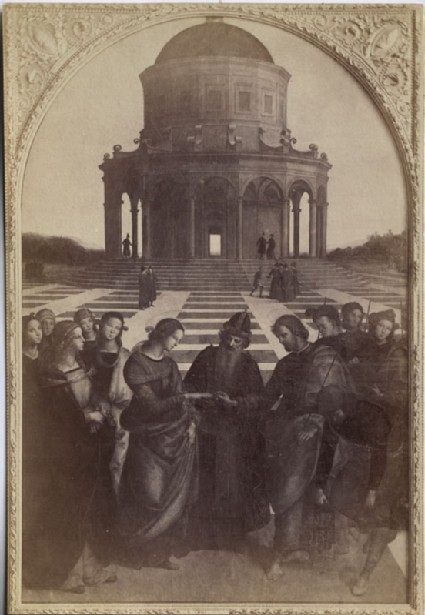Browse: 1470 objects
- Reference URL
Actions
Photograph of Raphael's "Marriage of the Virgin" Anonymous Italian
-
Curator’s description:
Description
The painting is shown in its decorated gilt frame with an arched top. The Virgin and Joseph stand either side of the centre, facing each other as the Virgin holds out her right hand and Joseph places a ring upon her finger with his left; he holds a thin rod with a spray of flowers sprouting from its tip. Between and behind them stands the priest. A group of five women stand behind the Virgin; opposite them, four men stand behind Joseph, each holding a similar rod (but without the flowers); in the bottom right corner, another man breaks his rod against his knee. The middle distance is filled with a broad pavement decorated with a pattern of squares which recede in perspective to the temple behind them; small groups of people appear on the pavement.
The photograph reproduces Raphael's celebrated painting of "The Marriage of the Virgin", painted in 1504 as an altarpiece for the Albizzini Chapel in the church of San Francesco in Città di Castello; as Ruskin noted, it is now in the Brera in Milan. The painting shows the story of the wedding of the Virgin and Joseph (recounted in the apocryphal "Protevangelium" and later in Jacobus of Voragine's 13th-century "Golden Legend"). The rods held by Joseph and the other men refer to the legend (recounted by St Jerome) whereby all the Virgin's suitors each brought a rod to the high priest of the Temple; Joseph's then blossomed, signifying that he had been divinely chosen to be the Virgin's husband. The women behind the Virgin may be intended for some of the seven virgins who witnessed the miracle, having been brought up with Mary in the Temple.
The photograph was first recorded in the Teaching Collection in 1870, when Ruskin listed it in frame 16 in the Standard Series in the "Catalogue of Examples", where he described it as 'one of the most beautiful works of Raphael's early time' - but attributed this to the quality of his teachers and predecessors, rather than to Rapahel's own talents. He seems to have considered this dependence to be a form of 'vital imitation' - i.e., healthy imitation - noting in "The Seven Lamps of Architecture" (ch. V, § 5 = VIII.196) how 'Raffaele ... borrows an entire composition from Perugino', presumably referring to Raphael's reworking in this picture of the composition of Perugino's slightly earlier "Marriage of the Virgin", now in the Musée des Beaux-Arts at Caen.
-
Details
- Artist/maker
-
Anonymous Italian (Anonymous, Italian) (photographer)after Raphael (1483 - 1520)
- Object type
- photograph
- Material and technique
- albumen print
- Dimensions
- 327 x 224 mm
- Inscription
- On the painting, reproduced in the photograph:
on the entablature of the arcade of the temple in the background: RAPHAELVRBINAS
in the spandrels of the arch immediately below: M. | DIIII
On the back of the mount:
top left, in graphite, underlined: large Gold
bottom right, in graphite: St. 16
towards bottom right, the Ruskin School's stamp
- Provenance
-
Presented by John Ruskin to the Ruskin Drawing School (University of Oxford), 1875; transferred from the Ruskin Drawing School to the Ashmolean Museum, c.1949.
- No. of items
- 1
- Accession no.
- WA.RS.STD.016
-
Subject terms allocated by curators:
Subjects
-
References in which this object is cited include:
References
Ruskin, John, Catalogue of Examples Arranged for Elementary Study in the University Galleries (Oxford: Clarendon Press, 1870), cat. Standard no. 16
Ruskin, John, Catalogue of the Reference Series Including Temporarily the First Section of the Standard Series (London: Smith, Elder, [1872]), cat. Standard no. 16
Ruskin, John, ‘The Ruskin Art Collection at Oxford: Catalogues, Notes and Instructions’, Edward T. Cook and Alexander Wedderburn, eds, The Works of John Ruskin: Library Edition, 39 (London: George Allen, 1903-1912), 21, cat. Standard no. 16
Ruskin, John, ‘The Seven Lamps of Architecture’, Edward T. Cook and Alexander Wedderburn, eds, The Works of John Ruskin: Library Edition, 39 (London: George Allen, 1903-1912), 8
Location
-
- Western Art Print Room
Position in Ruskin’s Collection
Ruskin's Catalogues
-
Ruskin's Catalogue of Examples (1870)
16. The Marriage of the Virgin. (Raphael .) Photograph from the picture in the Brera at Milan.One of the most beautiful works of Raphael’s early time; but its merit is rather to be considered as the final result of the teaching and practice of former schools than as an achievement of the master himself. Excellence is indeed fixed and measurable, however produced; but, in comparing artists with each other, we must remember that their relative merit depends, not on what they are, but on the degree in which they surpass their predecessors and teach their successors.
-
Ruskin's Standard & Reference series (1872)
16. The Marriage of the Virgin. (Raphael.) Photograph from the picture in the Brera at Milan .One of the most beautiful works of Raphael’s early time; but its merit is rather to be considered as the final result of the teaching and practice of former schools than as an achievement of the master himself. Excellence is indeed fixed and measurable, however produced; but, in comparing artists with each other, we must remember that their relative merit depends, not on what they are, but on the degree in which they surpass their predecessors, and teach their successors.





